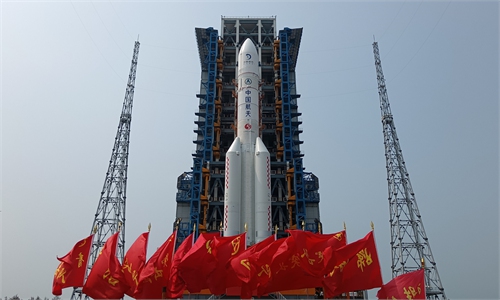ULM-1, an unidentified mineral crystal. Photo: CCTV news
Chinese scientists have discovered an unidentified mineral crystal called ULM-1 that is rich in water and ammonia molecules among samples returned by the Chang’e-5 lunar landing mission, a stunning breakthrough that indicates that for the first time, molecular water has been found in lunar soil.
Researchers from the Institute of Physics of the Chinese Academy of Sciences (CAS), along with scholars from several renowned Chinese universities, discovered ULM-1, an unidentified mineral crystal enriched with water molecules and ammonium on the moon from the Chang'e-5 lunar samples, shedding new light on potential sources of water and ammonia on the moon, China Central Television (CCTV) reported on Tuesday.
The research results have been published in the journal Nature Astronomy, according to CCTV.
The water and ammonium in the sample manifests as a hydrated mineral with the formula (NH4,K,Cs,Rb)MgCl3-6H2O.
The molecular formula of the mineral includes as many as six crystalline waters, with water molecules making up to 41 percent in the sample by mass.
Characteristic vibrational peaks derived from water molecules and ammonium are clearly detected on both the infrared and Raman spectra, with the charge density of the crystals offering a clear means of identifying hydrogen in the water molecules.
Notably, ULM-1's chemistry and crystal structure resemble a rare crater mineral that has been found recently on Earth.
They are created on Earth when hot basalt interacts with ammonia and water-rich volcanic gasses.
Researchers have carried out in-depth investigations of chloride isotopes and chemicals to guarantee the accuracy of the discovery.
As demonstrated by nanoscale secondary ion mass spectrometry data, the Cl isotopic composition of the mineral differs significantly from that of Earth minerals and matches that of minerals on the moon.
To further rule out Earth contamination and rocket exhaust as origins of the hydrate, scientists also examined the chemical makeup of the mineral and its production circumstances.
This new discovery carries considerable significance in various respects, CCTV said.
The bottom line of water content in the lunar volcanic gasses, according to thermodynamic analyses, was similar to that of Ol Doinyo Lengai in Tanzania, the driest volcano on Earth.
The findings therefore unveil a complex history of lunar volcanic degassing, which is of great significance to the exploration of the moon's evolutionary processes.
The existence of the hexahydrate mineral sets fundamental limitations on the composition of the lunar volcanic gases, CCTV said.
Also, the discovery revealed the possibility of water molecules’ presence in the form of hydrated salts on the moon, according to CCTV.
As a result, the findings open up new possibilities for the future development and utilization of lunar resources, as the research signifies that such stable hydrated salts can be produced even in the vast sunlit regions of the moon.
Without the lunar soil samples collected by the Chang'e-5 lunar probe, the successful finding would not have been possible. The samples, which are the youngest basalts ever discovered and come from the highest latitude on Earth to date, offer new opportunities for searching for lunar water.
Up until today, scientists had not discovered any solid proof of water molecules on the moon based on lunar samples from the Apollo missions.

